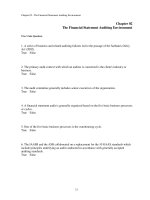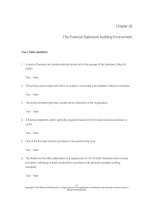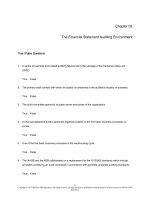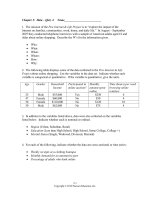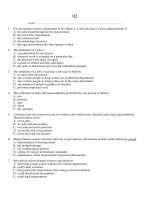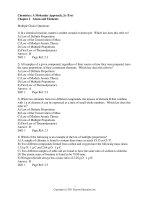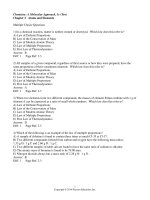Chemistry a molecular approach 2nd edition tro test bank
Bạn đang xem bản rút gọn của tài liệu. Xem và tải ngay bản đầy đủ của tài liệu tại đây (86.11 KB, 27 trang )
Chemistry: A Molecular Approach, 2e (Tro)
Chapter 2 Atoms and Elements
Multiple Choice Questions
1) In a chemical reaction, matter is neither created or destroyed. Which law does this refer to?
A) Law of Definite Proportions
B) Law of the Conservation of Mass
C) Law of Modern Atomic Theory
D) Law of Multiple Proportions
E) First Law of Thermodynamics
Answer: B
Diff: 1
Page Ref: 2.3
2) All samples of a given compound, regardless of their source or how they were prepared, have
the same proportions of their constituent elements. Which law does this refer to?
A) Law of Definite Proportions
B) Law of the Conservation of Mass
C) Law of Modern Atomic Theory
D) Law of Multiple Proportions
E) First Law of Thermodynamics
Answer: A
Diff: 1
Page Ref: 2.3
3) When two elements form two different compounds, the masses of element B that combine
with 1 g of element A can be expressed as a ratio of small whole numbers. Which law does this
refer to?
A) Law of Definite Proportions
B) Law of the Conservation of Mass
C) Law of Modern Atomic Theory
D) Law of Multiple Proportions
E) First Law of Thermodynamics
Answer: D
Diff: 1
Page Ref: 2.3
4) Which of the following is an example of the law of multiple proportions?
A) A sample of chlorine is found to contain three times as much Cl-35 as Cl-37.
B) Two different compounds formed from carbon and oxygen have the following mass ratios:
1.33 g O: 1 g C and 2.66 g O: 1 g C.
C) Two different samples of table salt are found to have the same ratio of sodium to chlorine.
D) The atomic mass of bromine is found to be 79.90 amu.
E) Nitrogen dioxide always has a mass ratio of 2.28 g O: 1 g N.
Answer: B
Diff: 1
Page Ref: 2.3
1
Copyright (c) 2011 Pearson Education, Inc.
5) Which of the following statements is FALSE according to Dalton's Atomic Theory?
A) Atoms combine in simple whole number ratios to form compounds.
B) All atoms of chlorine have identical properties that distinguish them from other elements.
C) One carbon atom will combine with one oxygen atom to form a molecule of carbon
monoxide.
D) Atoms of sodium do not change into another element during chemical reaction with chlorine.
E) An atom of nitrogen can be broken down into smaller particles that will still have the unique
properties of nitrogen.
Answer: E
Diff: 1
Page Ref: 2.3
6) Identify the description of an atom.
A) neutrons and electrons in nucleus; protons in orbitals
B) neutrons in nucleus; protons and electrons in orbitals
C) protons and neutrons in nucleus; electrons in orbitals
D) protons and electrons in nucleus; neutrons in orbitals
E) electrons in nucleus; protons and neutrons in orbitals
Answer: C
Diff: 1
Page Ref: 2.5
7) Identify the charges of the protons, neutrons, and electrons.
A) protons +1, neutrons 0, electrons -1
B) protons 0, neutrons -1, electrons +1
C) protons -1, neutrons 0, electrons +1
D) protons 0, neutrons +1, electrons -1
E) protons +1, neutrons -1, electrons 0
Answer: A
Diff: 1
Page Ref: 2.6
8) Isotopes differ in the number of what particle?
A) beta particles
B) protons
C) electrons
D) neutrons
E) gamma particles
Answer: D
Diff: 1
Page Ref: 2.6
9) The mass number is equal to
A) the sum of the number of the electrons and protons.
B) the sum of the number of the neutrons and electrons.
C) the sum of the number of protons, neutrons, and electrons.
D) the sum of the number of protons and neutrons.
Answer: D
Diff: 1
Page Ref: 2.6
2
Copyright (c) 2011 Pearson Education, Inc.
10) Identify the element that has an atomic number of 40.
A) neon
B) calcium
C) zirconium
D) bromine
Answer: C
Diff: 1
Page Ref: 2.6
11) What does "X" represent in the following symbol?
80
35 X
A) mercury
B) chlorine
C) scandium
D) bromine
E) selenium
Answer: D
Diff: 1
Page Ref: 2.6
12) What does "X" represent in the following symbol?
28
14 X
A) silicon
B) sulfur
C) zinc
D) ruthenium
E) nickel
Answer: A
Diff: 1
Page Ref: 2.6
13) What does "X" represent in the following symbol?
235
92 X
A) tin
B) copper
C) palladium
D) niobium
E) uranium
Answer: E
Diff: 1
Page Ref: 2.6
3
Copyright (c) 2011 Pearson Education, Inc.
14) Determine the number of protons, neutrons and electrons in the following:
40
18 X
A) p+ = 18 n° = 18
e- = 22
B) p+ = 18 n° = 22
e- = 18
C) p+ = 22 n° = 18
e- = 18
+
D) p = 18 n° = 22
e- = 40
E) p+ = 40
n° = 22 e- = 18
Answer: B
Diff: 1
Page Ref: 2.6
15) Determine the number of protons, neutrons and electrons in the following:
25
12 X
A) p+ = 12 n° = 25
e- = 12
B) p+ = 12 n° = 12
e- = 13
C) p+ = 12 n° = 13 e- = 12
D) p+ = 25 n° = 12
e- = 13
E) p+ = 12 n° = 13
e- = 25
Answer: C
Diff: 1
Page Ref: 2.6
16) Determine the number of protons, neutrons and electrons in the following:
65
29 X
A) p+ = 36
n° = 29 e- = 36
B) p+ = 29 n° = 29
e- = 36
C) p+ = 36 n° = 36 e- = 29
D) p+ = 29 n° = 36 e- = 29
E) p+ = 29 n° = 36 e- = 36
Answer: D
Diff: 1
Page Ref: 2.6
17) What element is defined by the following information?
p+ = 11
n° = 12
e- = 11
A) sodium
B) vanadium
C) magnesium
D) titanium
Answer: A
Diff: 1
Page Ref: 2.6
4
Copyright (c) 2011 Pearson Education, Inc.
18) What element is defined by the following information?
p+ = 20
n° = 20
e- = 20
A) zirconium
B) calcium
C) potassium
D) neon
E) argon
Answer: B
Diff: 1
Page Ref: 2.6
19) What element is defined by the following information?
p+ = 17 n° = 20
e- = 17
A) calcium
B) rubidium
C) chlorine
D) neon
E) oxygen
Answer: C
Diff: 1
Page Ref: 2.6
20) How many electrons are in arsenic?
A) 33
B) 41
C) 42
D) 41.9
E) 75
Answer: A
Diff: 1
Page Ref: 2.6
21) How many neutrons are in arsenic?
A) 33
B) 41
C) 42
D) 41.9
E) 75
Answer: C
Diff: 1
Page Ref: 2.6
22) How many protons are in arsenic?
A) 33
B) 41
C) 42
D) 41.9
E) 75
Answer: A
Diff: 1
Page Ref: 2.6
5
Copyright (c) 2011 Pearson Education, Inc.
23) Which of the following statements about subatomic particles is TRUE?
A) A neutral atom contains the same number of protons and electrons.
B) Protons have about the same mass as electrons.
C) Electrons make up most of the mass of an atom.
D) Protons and neutrons have opposite, but equal in magnitude, charges.
E) Neutrons and electrons are found in the nucleus of an atom.
Answer: A
Diff: 1
Page Ref: 2.6
24) Isotopes differ in the number of
A) protons
B) neutrons
C) electrons
D) none of the above
E) all of the above
Answer: B
Diff: 1
Page Ref: 2.6
25) Which of the following statements about isotopes is TRUE?
A) Isotopes of the same element differ only in the number of electrons they contain.
B) An isotope of an atom with a larger number of neutrons is larger than an isotope of the same
atom that contains fewer neutrons.
C) Isotopes of the same element have the same mass.
D) Isotopes of the same element don't usually have the same properties.
E) Some elements have 3 or more naturally occurring isotopes.
Answer: E
Diff: 1
Page Ref: 2.6
26) Give the symbol for fluorine.
A) F
B) Fl
C) Fo
D) Fu
E) Fr
Answer: A
Diff: 2
Page Ref: 2.6
27) Give the symbol for silver.
A) S
B) Si
C) Ar
D) Ag
E) Sl
Answer: D
Diff: 2
Page Ref: 2.6
6
Copyright (c) 2011 Pearson Education, Inc.
28) Identify a cation.
A) An atom that has lost an electron.
B) An atom that has gained an electron.
C) An atom that has lost a proton.
D) An atom that has gained a proton.
Answer: A
Diff: 2
Page Ref: 2.6
29) What species is represented by the following information?
p+ = 12
n° = 14
e- = 10
A) Si4+
B) Mg
C) Ne
D) Si
E) Mg2+
Answer: E
Diff: 2
Page Ref: 2.6
30) What species is represented by the following information?
p+ = 47
n° = 62
e- = 46
A) Ag+
B) Nd
C) Pd
D) Ag
E) Pd+
Answer: A
Diff: 2
Page Ref: 2.6
31) What species is represented by the following information?
p+ = 17
n° = 18
e- = 18
A) Cl
B) ClC) Ar
D) Ar+
E) Kr
Answer: B
Diff: 2
Page Ref: 2.6
7
Copyright (c) 2011 Pearson Education, Inc.
32) Predict the charge that an aluminum ion would have.
A) 5B) 1+
C) 1D) 2+
E) 3+
Answer: E
Diff: 2
Page Ref: 2.6
33) Predict the charge that a calcium ion would have.
A) 6B) 2C) 3+
D) 2+
E) 1+
Answer: D
Diff: 2
Page Ref: 2.6
34) Predict the charge that an ion formed from sulfur would have.
A) 1B) 6+
C) 3D) 4+
E) 2Answer: E
Diff: 2
Page Ref: 2.6
35) Predict the charge that the ion formed from bromine would have.
A) 1B) 2+
C) 1+
D) 4+
E) 2Answer: A
Diff: 2
Page Ref: 2.6
36) Give the number of neutrons in P-3.
A) 18
B) 12
C) 19
D) 15
E) 16
Answer: E
Diff: 2
Page Ref: 2.6
8
Copyright (c) 2011 Pearson Education, Inc.
37) Give the number of electrons in P-3.
A) 18
B) 12
C) 19
D) 15
E) 16
Answer: A
Diff: 2
Page Ref: 2.6
38) Give the number of protons in P-3.
A) 18
B) 12
C) 19
D) 15
E) 16
Answer: D
Diff: 2
Page Ref: 2.6
39) Identify the largest atom or ion of carbon.
A) p+ = 6 n° = 6
e- = 6
B) p+ = 6 n° = 7
e- = 6
C) p+ = 6 n° = 6
e- = 7
D) p+ = 6 n° = 6
e- = 5
Answer: C
Diff: 2
Page Ref: 2.6
40) Which of the following elements is NOT a metal?
A) Ba
B) Mg
C) Xe
D) Pb
E) Ga
Answer: C
Diff: 1
Page Ref: 2.7
41) Which of the following elements is a metal?
A) As
B) C
C) I
D) Sn
E) Se
Answer: D
Diff: 1
Page Ref: 2.7
9
Copyright (c) 2011 Pearson Education, Inc.
42) Which of the following elements is a nonmetal?
A) Zn
B) Cs
C) Ca
D) Co
E) P
Answer: E
Diff: 1
Page Ref: 2.7
43) Which of the following elements is a noble gas?
A) Ar
B) Br
C) N
D) O
E) K
Answer: A
Diff: 1
Page Ref: 2.7
44) Which of the following elements is a halogen?
A) Ne
B) I
C) O
D) Mg
E) K
Answer: B
Diff: 1
Page Ref: 2.7
45) Which of the following elements is an alkaline earth metal?
A) Cs
B) Cu
C) Mg
D) Ti
E) Br
Answer: C
Diff: 1
Page Ref: 2.7
46) Which of the following elements is an alkali metal?
A) Zn
B) Xe
C) F
D) Li
E) Ca
Answer: D
Diff: 1
Page Ref: 2.7
10
Copyright (c) 2011 Pearson Education, Inc.
47) Which of the following elements is a metalloid?
A) Al
B) Ge
C) C
D) Sn
Answer: B
Diff: 1
Page Ref: 2.7
48) Which of the following is a transition element?
A) Pd
B) Sn
C) K
D) U
E) Pr
Answer: A
Diff: 1
Page Ref: 2.7
49) Which of the following statements is FALSE?
A) Halogens are very reactive elements.
B) The alkali metals are fairly unreactive.
C) Sulfur is a main group element.
D) Noble gases do not usually form ions.
E) Zn is a transition metal.
Answer: B
Diff: 1
Page Ref: 2.7
50) Which of the following does NOT describe a metal?
A) good conductor of heat
B) good conductor of electricity
C) tends to gain electrons
D) forms ionic compounds with nonmetals
E) found on the left side of the periodic table.
Answer: C
Diff: 1
Page Ref: 2.7
51) Which of the following does NOT describe a nonmetal?
A) tend to gain electrons
B) found in the upper right hand corner of the periodic table
C) poor conductor of electricity
D) nonmetals are generally unreactive
E) poor conductor of heat
Answer: D
Diff: 1
Page Ref: 2.7
11
Copyright (c) 2011 Pearson Education, Inc.
52) Semiconductors are
A) metalloids.
B) noble gases.
C) nonmetals.
D) metals.
Answer: A
Diff: 1
Page Ref: 2.7
53) Which of the following statements is FALSE?
A) Anions are usually larger than their corresponding atom.
B) Metals tend to form cations.
C) Atoms are usually larger than their corresponding cation.
D) The halogens tend to form 1+ ions.
E) Nonmetals tend to gain electrons.
Answer: D
Diff: 1
Page Ref: 2.7
54) The atomic mass for cadmium is
A) 48
B) 112.41
C) 40.08
D) 20
Answer: B
Diff: 1
Page Ref: 2.8
55) The atomic mass for tin is
A) 47.87
B) 50
C) 118.71
D) 22
Answer: C
Diff: 1
Page Ref: 2.8
56) The atomic number for tin is
A) 47.87
B) 50
C) 118.71
D) 22
Answer: B
Diff: 1
Page Ref: 2.8
12
Copyright (c) 2011 Pearson Education, Inc.
57) Calculate the atomic mass of silver if silver has 2 naturally occurring isotopes with the
following masses and natural abundances:
Ag-107
Ag-109
106.90509 amu
108.90476 amu
51.84%
48.46%
A) 107.90 amu
B) 108.00 amu
C) 107.79 amu
D) 108.32 amu
E) 108.19 amu
Answer: E
Diff: 2
Page Ref: 2.8
58) Calculate the atomic mass of gallium if gallium has 2 naturally occurring isotopes with the
following masses and natural abundances:
Ga-69
Ga-71
68.9256 amu
70.9247 amu
60.11%
39.89%
A) 69.72 amu
B) 69.93 amu
C) 70.00 amu
D) 69.80 amu
E) 70.68 amu
Answer: A
Diff: 2
Page Ref: 2.8
59) Silver has an atomic mass of 107.868 amu. The Ag-109 isotope (108.905 amu) is 48.16%.
What is the amu of the other isotope?
A) 106.905 amu
B) 106.908 amu
C) 106.903 amu
D) 106.911 amu
Answer: A
Diff: 3
Page Ref: 2.8
60) Gallium has an atomic mass of 69.723 amu. The Ga-69 (68.926 amu) is 60.11%. What is
the amu of the other isotope?
A) 70.924 amu
B) 70.928 amu
C) 70.932 amu
D) 70.920 amu
Answer: A
Diff: 3
Page Ref: 2.8
13
Copyright (c) 2011 Pearson Education, Inc.
61) Calculate the atomic mass of element "X", if it has 2 naturally occurring isotopes with the
following masses and natural abundances:
X-45
X-47
44.8776 amu
46.9443 amu
32.88%
67.12%
A) 46.26 amu
B) 45.91 amu
C) 46.34 amu
D) 46.84 amu
E) 44.99 amu
Answer: A
Diff: 3
Page Ref: 2.8
62) Which of the following contains the MOST atoms? You shouldn't need to do a calculation
here.
A) 10.0 g Ne
B) 10.0 g He
C) 10.0 g Ar
D) 10.0 g Kr
E) 10.0 g Mg
Answer: B
Diff: 1
Page Ref: 2.9
63) Which of the following contains the FEWEST atoms? You shouldn't need to do a
calculation here.
A) 4.0 g Li
B) 4.0 g Na
C) 4.0 g Rb
D) 4.0 g K
E) 4.0 g Ca
Answer: C
Diff: 1
Page Ref: 2.9
64) How many silver atoms are contained in 3.75 moles of silver?
A) 6.23 × 1024 silver atoms
B) 2.26 × 1024 silver atoms
C) 1.61 × 1023 silver atoms
D) 2.44 × 1026 silver atoms
E) 6.50 × 1025 silver atoms
Answer: B
Diff: 2
Page Ref: 2.9
14
Copyright (c) 2011 Pearson Education, Inc.
65) How many xenon atoms are contained in 2.36 moles of xenon?
A) 3.92 × 1024 xenon atoms
B) 2.55 × 1023 xenon atoms
C) 1.42 × 1024 xenon atoms
D) 7.91 × 1025 xenon atoms
E) 1.87 × 1026 xenon atoms
Answer: C
Diff: 2
Page Ref: 2.9
66) How many argon atoms are contained in 7.66 x 105 mmol of argon?
A) 4.61 × 1026 Ar atoms
B) 1.84 × 1028 Ar atoms
C) 1.15 × 1028 Ar atoms
D) 7.86 × 1020 Ar atoms
E) 3.24 × 1026 Ar atoms
Answer: A
Diff: 2
Page Ref: 2.9
67) What mass (in g) does 3.99 moles of Kr have?
A) 334 g
B) 476 g
C) 211 g
D) 240 g
E) 144 g
Answer: A
Diff: 2
Page Ref: 2.9
68) How many moles of potassium are contained in 449 g of potassium?
A) 11.5 moles
B) 17.6 moles
C) 69.2 moles
D) 23.9 moles
E) 41.5 moles
Answer: A
Diff: 2
Page Ref: 2.9
69) How many moles are in 2.16 x 1024 atoms of lead?
A) 35.9 moles
B) 3.59 moles
C) 0.359 moles
D) 6.08 moles
E) 1.79 moles
Answer: B
Diff: 2
Page Ref: 2.9
15
Copyright (c) 2011 Pearson Education, Inc.
70) How many atoms are in 2.50 moles of CO2?
A) 4.52 x 1024 atoms
B) 1.52 x 1024 atoms
C) 5.02 x 1023 atoms
D) 3.01 x 1024 atoms
E) 7.53 x 1023 atoms
Answer: A
Diff: 3
Page Ref: 2.9
71) How many molecules are in 2.50 moles of CO2?
A) 4.52 x 1024 atoms
B) 1.51 x 1024 atoms
C) 5.02 x 1023 atoms
D) 3.01 x 1024 atoms
E) 7.53 x 1023 atoms
Answer: B
Diff: 3
Page Ref: 2.9
72) What mass (in kg) does 5.84 moles of titanium (Ti) have?
A) 0.352 kg
B) 0.122 kg
C) 0.820 kg
D) 0.280 kg
E) 0.632 kg
Answer: D
Diff: 3
Page Ref: 2.9
73) What mass (in mg) does 2.63 moles of nickel have?
A) 44.8 mg
B) 2.23 × 104 mg
C) 129 mg
D) 3.56 x 105 mg
E) 1.54 x 105 mg
Answer: E
Diff: 3
Page Ref: 2.9
74) How many moles of Kr are contained in 398 mg of Kr?
A) 4.75 × 10-3 moles Kr
B) 33.4 moles Kr
C) 2.11 × 10-4 moles Kr
D) 2.99 × 10-3 moles Kr
E) 1.19 × 10-4 moles Kr
Answer: A
Diff: 3
Page Ref: 2.9
16
Copyright (c) 2011 Pearson Education, Inc.
75) How many moles of Cs are contained in 595 kg of Cs?
A) 2.23 × 102 moles Cs
B) 4.48 × 103 moles Cs
C) 7.91 × 104 moles Cs
D) 1.26 × 103 moles Cs
E) 5.39 × 102 moles Cs
Answer: B
Diff: 3
Page Ref: 2.9
76) How many Li atoms are contained in 97.9 g of Li?
A) 5.90 × 1025 Li atoms
B) 7.09 × 1021 Li atoms
C) 8.49 × 1024 Li atoms
D) 4.27 × 1022 Li atoms
E) 4.18 × 1024 Li atoms
Answer: C
Diff: 3
Page Ref: 2.9
77) How many iron atoms are contained in 354 g of iron?
A) 2.62 × 1025 Fe atoms
B) 2.13 × 1026 Fe atoms
C) 4.69 × 1024 Fe atoms
D) 3.82 × 1024 Fe atoms
E) 9.50 × 1022 Fe atoms
Answer: D
Diff: 3
Page Ref: 2.9
78) How many phosphorus atoms are contained in 158 kg of phosphorus?
A) 3.07 × 1027 phosphorus atoms
B) 2.95 × 1027 phosphorus atoms
C) 3.25 × 1028 phosphorus atoms
D) 1.18 × 1024 phosphorus atoms
E) 8.47 × 1024 phosphorus atoms
Answer: A
Diff: 3
Page Ref: 2.9
79) Calculate the mass (in g) of 1.9 x 1024 atoms of Pb.
A) 3.9 × 102 g
B) 2.4 × 102 g
C) 3.2 × 102 g
D) 1.5 × 102 g
E) 6.5 × 102 g
Answer: E
Diff: 3
Page Ref: 2.9
17
Copyright (c) 2011 Pearson Education, Inc.
80) Calculate the mass (in kg) of 4.87 x 1025 atoms of Zn.
A) 5.29 kg
B) 1.89 kg
C) 8.09 kg
D) 1.24 kg
E) 1.09 kg
Answer: A
Diff: 4
Page Ref: 2.9
81) Calculate the mass (in ng) of 2.33 x 1020 atoms of oxygen.
A) 6.19 × 106 ng
B) 1.62 × 107 ng
C) 2.25 × 103 ng
D) 3.73 × 106 ng
E) 4.69 × 107 ng
Answer: A
Diff: 4
Page Ref: 2.9
Algorithmic Questions
1) An atom of 14C contains __________ protons.
A) 6
B) 20
C) 8
D) 10
E) 14
Answer: A
Diff: 1
Page Ref: 2.6
2) An atom of 131Xe contains __________ electrons.
A) 131
B) 185
C) 77
D) 123
E) 54
Answer: E
Diff: 1
Page Ref: 2.6
3) The atomic number of an atom of 80Br is __________.
A) 115
B) 35
C) 45
D) 73
E) 80
Answer: B
Diff: 1
Page Ref: 2.6
18
Copyright (c) 2011 Pearson Education, Inc.
4) An ion has 8 protons, 9 neutrons, and 10 electrons. The symbol for the ion is __________.
A) 17O2B) 17O2+
C) 19F+
D) 19FE) 17Ne2+
Answer: A
Diff: 1
Page Ref: 2.6
5) How many electrons does the Al3+ ion possess?
A) 16
B) 10
C) 6
D) 0
E) 13
Answer: B
Diff: 1
Page Ref: 2.6
6) How many protons does the Br- ion possess?
A) 34
B) 36
C) 6
D) 8
E) 35
Answer: E
Diff: 1
Page Ref: 2.6
7) Predict the charge of the most stable ion of bromine.
A) 2+
B) 1+
C) 3+
D) 1E) 2Answer: D
Diff: 1
Page Ref: 2.6
8) Predict the charge of the most stable ion of potassium.
A) 3+
B) 1C) 2+
D) 2E) 1+
Answer: E
Diff: 1
Page Ref: 2.6
19
Copyright (c) 2011 Pearson Education, Inc.
9) What is the chemical symbol for titanium?
A) Th
B) Ti
C) Tl
D) Tm
Answer: B
Diff: 2
Page Ref: 2.6
10) What is the chemical symbol for mercury?
A) Ag
B) Au
C) Hg
D) Pb
Answer: C
Diff: 2
Page Ref: 2.6
11) What is the chemical symbol for copper?
A) Co
B) Cr
C) Cu
D) C
Answer: C
Diff: 2
Page Ref: 2.6
12) Which element has the chemical symbol, Ru?
A) rubidium
B) ruthenium
C) rutherfordium
D) rhodium
Answer: B
Diff: 2
Page Ref: 2.6
13) Which element has the chemical symbol, S?
A) selenium
B) silicon
C) sulfur
D) scandium
Answer: C
Diff: 2
Page Ref: 2.6
14) Which are isotopes? An atom that has an atomic number of 20 and a mass number of 42 is
an isotope of an atom that has
A) an atomic number of 21 and a mass number of 42.
B) an atomic number of 20 and a mass number of 40.
C) 22 neutrons and 20 protons.
D) 22 protons and 20 neutrons.
Answer: B
Diff: 2
Page Ref: 2.6
20
Copyright (c) 2011 Pearson Education, Inc.
15) Which of the following represent isotopes?
A: 32
B: 32
15 X
16 X
A) A and B
B) A and C
C) A and D
D) C and D
Answer: B
Diff: 2
Page Ref: 2.6
31
C: 15
X
34
D: 17
X
16) How many protons (p) and neutrons (n) are in an atom of 90
38 Sr ?
A) 38 p, 52 n
B) 38 p, 90 n
C) 52 p, 38 n
D) 90 p, 38 n
Answer: A
Diff: 2
Page Ref: 2.6
17) How many protons (p) and neutrons (n) are in an atom of barium-130?
A) 56 p, 74 n
B) 56 p, 130 n
C) 74 p, 56 n
D) 130 p, 56 n
Answer: A
Diff: 2
Page Ref: 2.6
18) What is the element symbol for an atom that has 5 protons and 6 neutrons?
A) B
B) C
C) H
D) Na
Answer: A
Diff: 2
Page Ref: 2.6
19) How many electrons are in a neutral atom of bromine-81?
A) 1
B) 35
C) 36
D) 81
Answer: B
Diff: 2
Page Ref: 2.6
21
Copyright (c) 2011 Pearson Education, Inc.
20) Identify the chemical symbol of element Q in 80
34 Q .
A) Br
B) Hg
C) Pd
D) Se
Answer: D
Diff: 2
Page Ref: 2.6
21) An atom of 118Xe contains __________ neutrons.
A) 54
B) 172
C) 64
D) 110
E) 118
Answer: C
Diff: 2
Page Ref: 2.6
22) The mass number of an atom of 128Xe is __________.
A) 54
B) 182
C) 74
D) 128
E) 120
Answer: D
Diff: 2
Page Ref: 2.6
23) What is the identity of element Q if the ion Q2+ contains 10 electrons?
A) C
B) O
C) Ne
D) Mg
Answer: D
Diff: 2
Page Ref: 2.6
24) How many electrons are in the ion, Cu2+?
A) 27
B) 29
C) 31
D) 64
Answer: A
Diff: 2
Page Ref: 2.6
22
Copyright (c) 2011 Pearson Education, Inc.
25) How many electrons are in the ion, P3-?
A) 12
B) 18
C) 28
D) 34
Answer: B
Diff: 2
Page Ref: 2.6
26) In which of the following sets do all species have the same number of electrons?
A) F-, Ne, Mg2+
B) Ge, Se2-, BrC) K+, Rb+, Cs+
D) Br, Br-, Br+
Answer: A
Diff: 2
Page Ref: 2.6
27) In which of the following sets do all species have the same number of protons?
A) F-, Ne, Mg2+
B) Ge, Se2-, BrC) K+, Rb+, Cs+
D) Br, Br-, Br+
Answer: D
Diff: 2
Page Ref: 2.6
28) Cesium belongs to the __________ group of the periodic table.
A) alkali metal
B) alkaline earth metal
C) halogen
D) noble gas
Answer: A
Diff: 1
Page Ref: 2.7
29) Iodine belongs to the __________ group of the periodic table.
A) alkali metal
B) alkaline earth metal
C) halogen
D) noble gas
Answer: C
Diff: 1
Page Ref: 2.7
30) Argon belongs to the __________ group of the periodic table.
A) alkali metal
B) alkaline earth metal
C) halogen
D) noble gas
Answer: D
Diff: 1
Page Ref: 2.7
23
Copyright (c) 2011 Pearson Education, Inc.
31) Barium belongs to the __________ group of the periodic table.
A) alkali metal
B) alkaline earth metal
C) halogen
D) noble gas
Answer: B
Diff: 1
Page Ref: 2.7
32) Which of the following elements has chemical properties similar to tellurium?
A) fluorine
B) hydrogen
C) nitrogen
D) sulfur
Answer: D
Diff: 1
Page Ref: 2.7
33) Which of the following elements is a gas at room temperature?
A) bromine
B) carbon
C) helium
D) sodium
Answer: C
Diff: 1
Page Ref: 2.7
34) Which of the following elements is not a solid at room temperature?
A) Ag
B) Al
C) Xe
D) Fe
Answer: C
Diff: 1
Page Ref: 2.7
35) Which of the following elements is classified as a semimetal?
A) calcium
B) boron
C) fluorine
D) uranium
Answer: B
Diff: 1
Page Ref: 2.7
36) Which of the following elements is a good conductor of heat and electricity?
A) carbon
B) chlorine
C) neon
D) aluminum
Answer: D
Diff: 1
Page Ref: 2.7
24
Copyright (c) 2011 Pearson Education, Inc.
37) Which one of the following elements is a poor conductor of heat and electricity?
A) copper
B) fluorine
C) iron
D) lead
Answer: B
Diff: 1
Page Ref: 2.7
38) All of the following elements are nonmetals except
A) barium.
B) carbon.
C) hydrogen.
D) oxygen.
Answer: A
Diff: 1
Page Ref: 2.7
Matching Questions
Match the following.
A) C
B) Mg
C) Fe
D) K
E) Si
1) magnesium
Diff: 1
Page Ref: 2.6
2) carbon
Diff: 1
Page Ref: 2.6
3) potassium
Diff: 1
Page Ref: 2.6
4) iron
Diff: 1
Page Ref: 2.6
5) silicon
Diff: 1
Page Ref: 2.6
Answers: 1) B 2) A 3) D 4) C 5) E
25
Copyright (c) 2011 Pearson Education, Inc.
